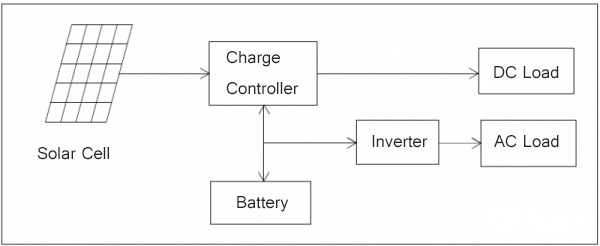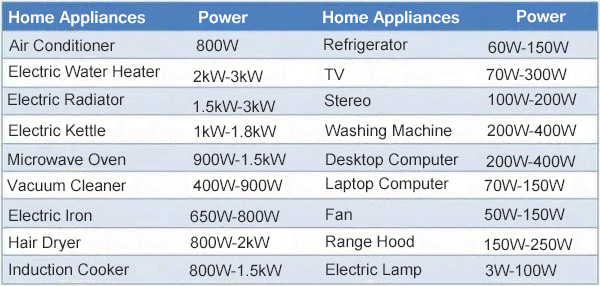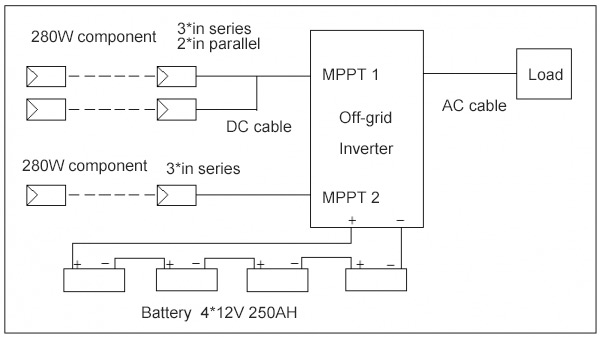The off-grid photovoltaic power generation system for household use consists of the photovoltaic module, supporter, controller, solar inverter, accumulator, and power distribution system. The system's electric plan design should take the selection and computing of modules, inverters (controllers), and accumulators into consideration. Before the plan design, necessary preparation should be made, because the off-grid is customized without a unified plan. Therefore, the user load type and power, electricity consumption in the daytime and in the evening, and climate conditions of the installation place should be first learned. The power supply for the off-grid photovoltaic system relies on the weather, which is not 100% reliable.

The off-grid solar system must be equipped with an accumulator, which takes up 30% to 50% of the power generation system costs. Meanwhile, the general service life of the lead-acid accumulator ranges from 3 years to 5 years. After the expiration of its service life, an exchange is necessary. From the economic point of view, the accumulator can hardly find wide applications on an extensive scale, and it is only applicable to places suffering from a shortage of power supply.
The off-grid system is different from the grid-connected system. Components and inverters are not configured in a certain proportion, but are designed according to the user's load, electricity consumption, and local weather conditions:
Confirm inverter power based on user's load type and power
Generally, the load for home use can be divided into inductive load and resistive load. The load with the motor, such as the washing machine, air-conditioner, refrigerator, water pump, and smoke exhaust ventilator is the inductive load. The motor start-up power is three to five holds as much as that of the rated power. In computing the inverter's power, it is necessary to take the start-up power of the load into consideration. The output power of the off-grid inverter is higher than the load power. However, for impoverished families, it is impossible to start all loads. Therefore, in order to save costs, the sum of the load power can be multiplied by the coefficient, ranging from 0.7 to 0.9. Below is a list of the power of electric devices for household use, which is for reference upon design.

Determine module power based on user's daily electricity consumption
Electricity is available for the off-grid system = Total power of modules × Average hours of solar power consumption × Efficiency of controller × Efficiency of the accumulator. In principle, the module should be designed to satisfy the daily electricity consumption of the load under general weather conditions. In other words, the daily power generation of the solar cell module should be larger than the load's daily electricity consumption. Since the weather conditions are either lower or higher than the average, the solar cell module design should basically satisfy the need of the season with the poorest illumination. In other words, the accumulator should be ensured to be fully charged in the season with the poorest illumination. However, the seasonal poorest illumination in some places is far lower than the annual average. If the power of the solar cell module is still designed according to the poorest conditions, then the annual power generation might far exceed the actual demand, thus causing huge waste. Under the condition, the designed capacity of the accumulator should be properly increased to enlarge the electric energy storage and ensure the accumulator is at a shallow discharge status, which can make up for the shortage of power generation in the season with the poorest illumination, and prevent it from damaging the accumulator cell. The power generated by the module cannot be fully converted into power for use, because the controller efficiency, machine loss, and accumulator loss should also be considered. This is where the 2000W off-grid inverter comes into play, ensuring efficient conversion and management of the generated power.
The installation angle of the module should consider the user's geographical location to satisfy the user's requirements in the summer and winter. The angle of the solar cell generally faces the south so that the power generated by the solar cell unit capacity can be maximized. The most ideal tilt angle is to maximize the annual power generation of the solar cell while minimizing the difference in power generation between winter and summer.
The electricity consumption of the load like the bulb, electric fan, and electric hair dryer equals the power multiplied by the time. As to the load, such as the air-conditioner and refrigerator, the air-conditioner's power consumption has a close bearing on the temperature difference between the indoor and the outdoor, the housing area, and the air-conditioner's energy efficiency. One 1P air-conditioner, if used for eight hours a night, consumes 1 to 5 kilowatts of electricity.
Determine accumulator capacity based on night use or standby time
The task of the accumulator is to ensure the system load's normal power use when the solar radiation is insufficient. The important load should ensure the system to function normally in several days, and the number of successive overcast and rainy days should be considered. In terms of general loads, such as the solar streetlamp, the accumulator capacity should be selected in two to three days according to experience or need. For impoverished families, price is the main consideration. The accumulator is not needed on rainy and overcast days and is used when there is ample sunlight. When the sunlight is insufficient or there is no sun, then the accumulator will not be used. When choosing loads, you should choose energy-saving devices, such as LED lights, variable-frequency air conditioners, etc. The accumulator designer includes the accumulator capacity design and the accumulator cell series-parallel connection combination. In the photovoltaic power generation system, the lead-acid accumulator is often used. Considering the life span of the battery, the depth of discharge is generally set to be 0.5 to 0.7. Designed capacity of the accumulator = (Average daily electricity use of the load × Number of successive overcast and rainy days) / Accumulator's depth of discharge.
Design a plan for a 4000-watt system for household use
The client’s electricity use demand: Lighting (200W, 6 hours a day), Refrigerator (50W, 24 hours a day), Frequency-variable air-conditioner (1hp, 12 hours a day), Television (50W, 10 hours a day). Other household appliances used for an unfixed length of time, including the washing machine, desktop, electric cooker, electric fan, etc.

1. Statistics of the total load power
The lighting is 200W, the refrigerator is 50W, the air-conditioner is 750W, the television is 50W, the washing machine is 300W, the desktop is 200W, the electric cooker is 1200W and the electric fan is 100W. In total, they are 2,850W. Therefore, the 4000W off-grid solar inverter is selected.
2. Statistics of daily electricity use
The lighting consumes 1.2 kWh, the refrigerator consumes 1 kWh, the air-conditioner consumes 2 kWh, the television consumes 0.5kw, the washing machine consumes 1 kWh, the desktop consumes 0.5 kWh, the electric cooker consumes 1 kWh, the electric fan consumes 0.5 kWh. They are 7.7 kWh in total. In fact, the daily electricity consumption averages around 6 to 10 kWh. In some areas, the illumination conditions are favorable, which can last for 4.5 hours every day. 9 pieces of 280W modules are adopted for design, whose electricity consumption totals 2.52kW, and can generate 11.34 kWh. The off-grid system has a low efficiency of around 0.8, and the average daily available electricity is 9 kWh. It can generally satisfy more than 99% of the electricity use demands.
3. Computing of the accumulator
The electric devices for home use are mostly used in the evening, leaving only 20% for the daytime. In order to increase the life span of the accumulator, the accumulator capacity can be properly increased, for the daily depth of discharge is low. This project adopts four sections of a 12V 250AH colloid lead-acid accumulator, whose total capacity is 12,000 VAH. The utilizable electricity quantity is around 8.4 kWh, and the average electricity consumption at night is 6 kWh. The depth of discharge is around 50%.
We hope you are satisfied with the design solutions provided by Inverter.com. If you have any questions, please feel free to contact us.
